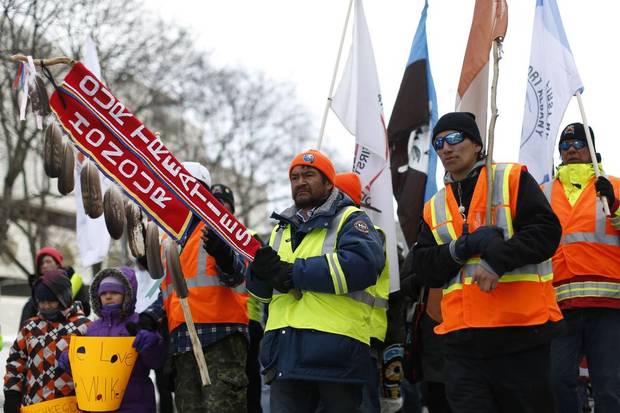
A group of First Nations adults and youth finish a spiritual journey from Attawapiskat First Nation to Parliament Hill on Feb. 24, 2014.
SEAN KILPATRICK/THE CANADIAN PRESS
Where is Attawapiskat? The Attawapiskat First Nation is located at the mouth of the Attawapiskat River on James Bay in Northern Ontario and is home to about 2,000 people. It has been plagued by suicides for decades.
How did it start? The suicide epidemic in Attawapiskat started in the fall, when a number of people tried to kill themselves, said Jackie Hookimaw, a member of the community. She said the latest round of youth suicide attempts started with the death of her great-niece Sheridan, who took her life in October. She was 13 years old.
What is being done? Chief Bruce Shisheesh and council declared a state of emergency on Saturday. The designation has meant that a Nishnawbe Aski Nation crisis response unit is being sent to the community. The federal and Ontario health ministers said the Weeneebayko Area Health Authority hospital was immediately flying in a crisis team, including mental health nurses and social workers. Meanwhile, Perry Bellegarde, national chief of the Assembly of First Nations, said he has offered Chief Shisheesh his support and is pressing for long-term help for the community in addition to immediate action, adding that the crisis is a "national tragedy."
Understand resources on way to #Attawapiskat today. Thanks to @JanePhilpott @DrEricHoskins for their support. https://t.co/zQ8CuNQrul
— Perry Bellegarde (@perrybellegarde) April 11, 2016
The news from Attawapiskat is heartbreaking. We'll continue to work to improve living conditions for all Indigenous peoples.
— Justin Trudeau (@JustinTrudeau) April 10, 2016
The crisis in context
1. Suicide is not just an Attawapiskat problem
Previous studies have suggested suicide and self-inflicted injuries are among the leading causes of death among First Nations, Métis and Inuit people. Waves of suicides like the one in Attawapiskat are not new, but several others in recent months have gained renewed attention – such as a string of deaths in northern Manitoba's Pimicikamak Cree Nation, also known as Cross Lake, which has also declared a state of emergency.
A grave site for Finola Muswaggon, who died at Cross Lake in March, 2016. She was 14.
ANN MARY FOR THE GLOBE AND MAIL
Mr. Bellegarde said last month that there should be a national strategy to combat indigenous suicide. "Our young people need hope and inspiration," Mr. Bellegarde said. "They don't see that right now. We've got to make those key strategic interventions now. It's a life-and-death situation."
2. Suicide is not just an on-reserve problem
The renewed attention on suicide crises on reserve had led some critics to propose urban resettlement as a solution. Indigenous suicide problems do not disappear in cities, however. A Statistics Canada report released in January found that more than one in five off-reserve First Nations, Métis and Inuit adults reported having suicidal thoughts at some point in their lives.
Problems with suicide on reserve can be more acute, though, due to challenges of distance and availability of mental-health services. Charlie Angus, the MP for the Attawapiskat area and NDP indigenous affairs critic, said northern communities aren't given the resources to deal with complicated grief. "When a young person tries to commit suicide in any suburban school, they send in the resources, they send in the emergency team. There's a standard protocol for response. The northern communities are left on their own," he said. "We don't have the mental health service dollars. We don't have the resources."
3. Indigenous suicide is not just a mental-health problem
Conditions on reserves lag behind those in the rest of Canada in more respects than just suicide and health: Unemployment, lack of access to education and substandard infrastructure are factors too. Attawapiskat declared a state of emergency five years ago over a housing crisis that James Anaya, then UN Special Rapporteur on indigenous peoples, said "seems to represent the condition of many First Nation communities living on reserves throughout Canada, which is allegedly akin to Third World conditions."
Studies have pointed to economic hardships and the legacy of colonialism as key factors in high indigenous suicide rates. The January Statscan study, for instance – which reviewed findings from the 2012 Aboriginal Peoples Survey and the 2012 Canadian Community Health Survey – found a strong connection between residential-school experience and suicidal thoughts. Doing more to prevent suicide was one of the recommendations of last June's report by the Truth and Reconciliation Commission on residential schools.
Federal Health Minister Jane Philpott said in a statement regarding the Attawapiskat suicide crisis that improving the wellness of indigenous peoples will require a focus on improving the socioeconomic conditions they face. "I have worked with the province to set up a joint action table so that federal and provincial governments can work together, hand-in-hand with First Nations leadership, to find concrete solutions," Ms. Philpott said.
4. Attawapiskat is more than just a community with problems
During some of Attawapiskat's previous moments in the national spotlight – the housing crisis, former chief Theresa Spence's contentious role in the Idle No More movement – Attawapiskat residents have sometimes criticized outside observers for only paying attention during times of crisis.
Residents tried to challenge that narrative in 2014 with a 1,000-kilometre trek to Ottawa to urge politicians and First Nations chiefs to renew discussion of treaty rights.

Danny Metatawabin, middle, walks with fellow Omushkegowuk Walkers and supporters while marching towards Parliament Hill in Ottawa on Feb. 24, 2014.
CHRIS WATTIE/REUTERS
Youth from Attawapiskat and neighbouring communities held a healing walk last week to create awareness of the current suicide crisis, Jackie Hookimaw told The Canadian Press. "They said, 'We will not give up, because our youth are killing themselves … We will not be defeated.'"
Graphics by Murat Yükselir
With report from Evan Annett and Gloria Galloway
MORE READING
‘Something horribly wrong’ with First Nations health: Chief
0:32


